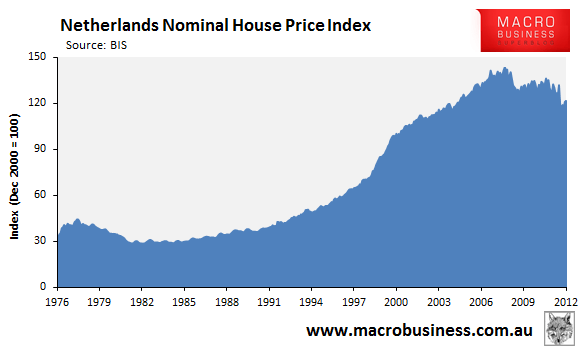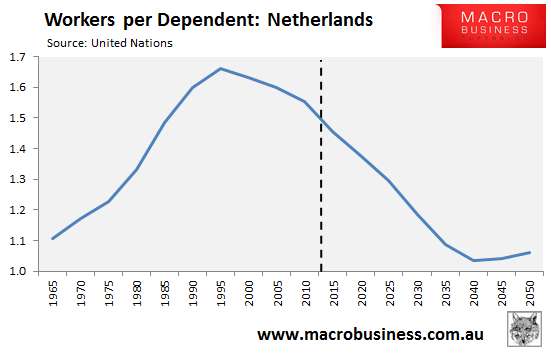
I have written previously how the Netherlands housing system all but guarantees unaffordable housing and a susceptibility to housing bubbles, via:
- ridiculously easy credit, with a third of mortgages guaranteed by the government;
- mortgage interest tax relief and generous subsidies offered to home buyers;
- a dysfunctional rental market that encourages households to strive for owner-occupation; and
- severely restricted housing supply, which ensures that changes in demand flow predominantly into homes prices rather than new construction.
Now the Dutch are paying the price for its bubbly housing policy, with house price falls continuing to accelerate. According to the National Statistics Agency, Dutch house prices fell by -8% in the year to December 2012 to be down -18% since prices peaked in 2008. Nominal prices are now back at June 2005 levels (see next chart).

The sharp fall in house prices is having an adverse impact on the Dutch economy, with household disposable income, consumer confidence, unemployment and economic growth all weakening significantly.
Due in part to the Netherlands’ generous mortgage tax relief, which allows home owners to deduct from tax all interest payments for a maximum period of 30 years, as well as a series of exotic “interest-only” mortgage products created to maximise tax deductions, Netherlands’ mortgage debt is among the world’s highest, amounting to 110% GDP currently according to the Dutch central bank.

However, the decline in house prices, combined with high levels of mortgage debt, has now left many Dutch households exposed to ‘negative equity’, whereby the property is worth less than the mortgage debt. And the reduction in household wealth is contributing to the downturn in household spending, which is exacerbating the the Netherlands’ current economic slowdown. From the Economist:
The Dutch weakness is consumer spending, which has been falling for a year and a half. Household consumption last year was lower than in 2006. Consumer confidence fell to the lowest level ever measured in February. The chief source of anxiety has been house prices. Over the past decade, Dutch housing experienced a bubble comparable to those in Spain or Ireland. But house prices dropped by 6% last year and have fallen by 16.6% from their peak. Feeling poorer, homeowners have simply stopped spending.
The outlook is not good either. The European Commission recently cut its forecast for the Dutch economy and now expects a second consecutive year of contraction as domestic demand remains depressed. Meanwhile, in its Article IV consultation, concluded last week, the IMF noted that “the ongoing but necessary deleveraging of household and bank balance sheets will continue to weigh on economic activity over the medium term”, whilst also acknowledging that the “banking system still remains heavily exposed to the real estate sector and dependent on wholesale funding, and its process of balance sheet adjustment is also expected to remain in train for the foreseeable future”.
The IMF also forecast Dutch GDP to “contract by 0.5 percent in 2013 before gradually recovering by 1.1 percent in 2014” and noted that risks are skewed to the downside:
The interaction of household and bank balance sheets linked through changes in house prices makes the outlook subject to unusually large uncertainty. Expectations that house prices need to adjust by more than is currently assumed would restrain both household consumption and lending by banks, which could in turn lead to a continuing cycle of falling house prices and deleveraging.
To add insult to injury, the Netherlands is facing a rapidly ageing population, which is likely to drag on consumption and growth for decades to come, and hinder the economy’s ability to sustain high levels of household debt (see next chart).

Clearly, there is more pain to come for the Dutch economy, which is now paying the price for years of poor housing policy.

